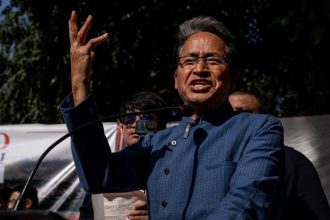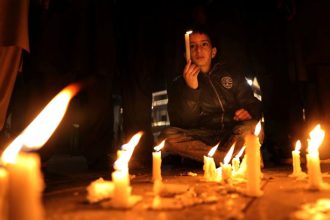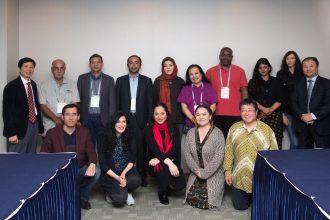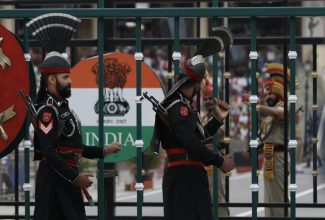India at the Crossroads: Trump’s 25% Tariff and the BRICS Balancing Act
The U.S. has slapped a 25% tariff on Indian imports, citing unfair trade practices and India’s ties with Russia. As New Delhi prepares to lead BRICS in 2026, the move raises high-stakes questions about India’s global strategy and its future in an increasingly polarized world.

By Gunjeet Sra
NEW DELHI: On July 30, 2025, U.S. President Donald Trump stunned policymakers and markets alike by announcing a sweeping 25% tariff on all Indian imports. Effective August 1, the tariffs are accompanied by an unspecified “penalty” aimed at punishing India for its continued purchase of Russian crude oil and defense equipment. Though Trump insisted that India remains a “friend,” his tone was unmistakably critical, accusing New Delhi of maintaining some of the “most strenuous and obnoxious trade barriers anywhere in the world.”
What initially appears to be a trade dispute is in fact a potent cocktail of geopolitics, strategic messaging, and economic power play. At the heart of this tariff imposition is a broader anxiety within Washington about India’s growing leadership role within BRICS—the Brazil-Russia-India-China-South Africa grouping—and its increasing push for a multipolar world order.
A Tariff Beyond Trade
India’s relatively high tariff rates, averaging between 12% and 16% across sectors such as agriculture, dairy, and manufactured goods have long been a sticking point in the U.S-India trade talks. Although there is an understanding that the current escalation is not solely about tariffs, Trump’s announcement reflects growing unease about India’s posture on the global stage, especially its economic and energy ties with Russia at a time when Washington continues to lead efforts to isolate the Kremlin over the war in Ukraine.
The vague yet ominous “penalty” threatened by Trump likely foreshadows further trade or financial restrictions, perhaps targeting sectors that benefit from discounted Russian oil or defense collaboration. The threat is clear, align more closely with the U.S. or pay the price.
The BRICS Balancing Act
India’s growing prominence in BRICS is central to the current tension. At the recent BRICS summit in Rio de Janeiro, Prime Minister, Narendra Modi, outlined a vision of reform and resilience, promoting sustainability, institutional overhaul, and Global South solidarity. With India set to chair BRICS in 2026, its leadership role is more visible and more scrutinized than ever.
Yet India’s position within BRICS is not an easy one. It is one of the few members with deep ties to both the West and the developing world. Unlike China or Russia, India has avoided pushing for full-scale de-dollarisation or anti-Western rhetoric. Instead, its engagement has centered on development, climate justice, and equitable global governance. But its continued trade with Russia and its refusal to sever longstanding defense ties has irked Washington at a time when global alliances are being redrawn in sharp binary lines.
What India sees as strategic autonomy, others increasingly view as fence-sitting.
Domestic Ripples and Global Signals
The economic fallout of the tariffs was immediate. Export-driven sectors across India, particularly in Gujarat, known for its chemicals, ceramics, and textiles warned of heavy losses and contract disruptions. The Indian rupee weakened, reaching a multi-month low against the U.S. dollar. Financial analysts speculated that the Reserve Bank of India may need to intervene to stabilize the currency.
Politically, reactions were swift. The Modi government maintained a cautious tone, signaling that trade talks were still ongoing.
Opposition leaders, however, seized the moment to critique what they termed the failure of a personality-driven foreign policy that placed too much faith in U.S. goodwill.
Indian business leaders urged a reorientation. “This is a wake-up call,” tweeted industrialist Harsh Goenka. “Time to pivot toward Europe and ASEAN.” The sentiment reflects a growing consensus: India needs to diversify its trade relationships before external pressure becomes a persistent vulnerability.
Legal Avenues and Strategic Dilemmas
Trump’s use of trade as a punitive weapon isn’t new. During his previous administration, similar tariff actions were challenged in U.S. courts, with cases like V.O.S. Selections, Inc. v. United States questioning the limits of executive power in economic matters. Legal scholars suggest this round of tariffs could face similar scrutiny, particularly if the accompanying penalties lack clarity or statutory basis.
For India, the strategic dilemma is intensifying. Can it continue to engage constructively with Russia while maintaining vital economic ties with the U.S.? Can it lead a reformist BRICS while remaining indispensable to the West’s Indo-Pacific vision?
Trump’s move makes it harder to sustain a balanced path. The challenge ahead is not just to respond to tariffs or appease one power bloc over another. The challenge is to demonstrate that strategic autonomy is not indecision, and that a country can aspire to global leadership without becoming anyone’s pawn.
AsiaN Korean Edition: https://kor.theasian.asia/archives/388872




